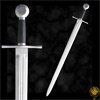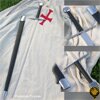|
|
|
 |
|
| Hanwei Tinker Longsword Replacement Blade - Sharp (OH2396) |
Points: 5

|
This sharp Longsword blade may be used either to replace severely worn blades of the cutting sharp Tinker Longsword (Product No. HN-SH2394) or to convert the blunt sparring version of the Tinker Longsword (Product No. HN-SH2395) to a sharp weapon.
|
|
|
|
|
|
 |
|
| Hanwei Tinker Great Sword of War (SH2424) |
Points: 15


|
The Great Sword of War is designed and crafted purely as a cutting sword and, weighing a little less than four pounds, it is built to excel on heavy targets.
|
|
|
|
|
|
 |
|
| Hanwei Tinker Pearce Norman Sword - Sharp (SH2426) |
Points: 10


|
The Tinker Norman sword pair, with their distinctive cruciform guard and brazil-nut pommel, are similar in weight and static balance and offer virtually identical handling characteristics. Both are harmonically balanced, optimizing cutting ability in the case of this sharp version.
|
|
|
|
|
|
 |
|
| Hanwei Tinker Pearce Early Viking Sword - Sharp (SH2408) |
Points: 10


|
Early Medieval Sword designed by Michael `Tinker` Pearce and reproduced by Hanwei to his specifications.
The swords meet Tinker`s exacting quality requirements and are built in much the same way as his custom pieces. Each blade is forged from 5160 Spring Steel, Marquenched to the desired hardness of 50-53 Hrc while the tang is drawn back to the low 30s Hrc. The very end of the tang is threaded to fit an allen nut recessed into the pommel which allows for dimantling of the hilt assembly for inspection or to exchange blades if needed.
|
|
|
|
|
|
 |
|
| Hanwei Sir William Marshall Sword (SH2000) |
Points: 14

|
The Hanwei Marshall Sword one-handed sword embodies the quality and authenticity of a sword design. The appearance of the sword is based on the original, currently in the British museum, used by one of the best knights of England, Sir William Marshall, who faithfully served the crown under the reign of Henry II, Richard the Lionheart and Jack Lackland.
|
|
|
|
|
|
 |
|
| Hanwei Sir William Marshall Sword Damascus Steel (SH2001) |
Points: 35

|
Hanwei Sir Marshall Sword folded steel sets new quality standards in sword design.
The sword is based on the original, currently in the British museum, used by one of the best knights of England, Sir William Marshall, who faithfully served the crown under the reign of Henry II, Richard Lionheart and Jack Lackland.
|
|
|
|
|
|
 |
|
| Hanwei River Witham Sword (SH2372) |
Points: 11

|
The River Witham Sword was dredged from the River Witham near the town of Lincoln during work carried out in 1788. The sword may be a remnant of the Battle of Lincoln in 1141; however, it was most likely constructed between 1250-1300 CE. The inscription on the blade reads +NDXOXCHMDRCHDXORVI+. Iberia Swords are crafted in much the same way as swords were made centuries ago, except that the blades are now forged from high-carbon spring steel, a resource unavailable off-the-shelf to the smiths of the old. The blade finish is far from being polished, again more closely replicating what the medieval swordsmith was able to achieve. Except as noted, grips are leather-covered hardwood. Fittings are either steel or solid brass. Except, where shown all of these swords have scabbards of leather-covered wood with steel lockets and chapes and removable suspension rings. These swords will appeal to the re-enactor who wants a sword with the same appearance as the originals.
|
|
|
|
|
|
 |
|
| Hanwei Cawood Viking Sword (SH2457) |
Points: 24

|
The celebrated Cawood Sword, named after its discovery location near Cawood Castle in England, is regarded as one of the finest and best-preserved examples of an 11th century Viking sword in existence. Preserved in the mud of the bed of the River Ouse for almost a millenium, the sword has now found a permanent home in the Yorkshire Museum, where it is a leading attraction. What is almost certainly a “sister” sword was unearthed in Norway in 1888, giving a valuable clue to the Cawood Sword’s origin.
|
|
|
|
|
|
 |
|
| Hanwei Saxon Sword 9th century (SH2436) |
Points: 25

|
CAS Hanwei’s smiths have outdone themselves with their recreation of a 9th Century Saxon sword by replicating a technique used by the Saxons and Vikings and producing a stunning blade that features a pattern-welded core with high-carbon edge sections. This technique was used by the old-time smiths as a means of producing blades (just for the rich folks) that were sharp, resilient and decorative and, eleven hundred years on, CAS Hanwei has made them affordable.
The sword’s design is based on a 9th Century piece found in the bank of a stream in England in 1976 and now on display in the Yorkshire Museum.
|
|
|
|
|
|
 |
|
| Hanwei Early Medieval Single Hand - Tinker Pearce Sharp (SH2404) |
Points: 13

|
Early Medieval Sword designed by Michael `Tinker` Pearce and reproduced by Hanwei to his specifications.
The swords meet Tinker`s exacting quality requirements and are built in much the same way as his custom pieces. Each blade is forged from 5160 Spring Steel, Marquenched to the desired hardness of 50-53 Hrc while the tang is drawn back to the low 30s Hrc. The very end of the tang is threaded to fit an allen nut recessed into the pommel which allows for dimantling of the hilt assembly for inspection or to exchange blades if needed.
|
|
|
|
|
|
 |
|
| Hanwei Hand and a Half Sword - Tinker Pearce Sharp |
Points: 10

|
Bastard Sword designed by Michael `Tinker` Pearce and reproduced by Hanwei to his specifications.
The swords meet Tinker`s exacting quality requirements and are built in much the same way as his custom pieces. Each blade is forged from 5160 Spring Steel, Marquenched to the desired hardness of 50-53 Hrc while the tang is drawn back to the low 30s Hrc. The very end of the tang is threaded to fit an allen nut recessed into the pommel which allows for dimantling of the hilt assembly for inspection or to exchange blades if needed.
|
|
|
|
|
|
 |
|
| Hanwei Gustav Rapier (SH2206) |
Points: 12

|
The Gustav Rapier and Main Gauche replicate weapons used by King Gustav Adolf II, who ruled Sweden in the early part of the 17th century. The shell guard of the rapier is unusual but effective. Available in both bright and antiqued versions. A replacement live blade is also available (OH2327).
All of our rapiers have stainless steel hilts, for reduced maintenance, and high-carbon steel flex-tempered blades. Our three swept-hilt styles (Solingen, Torino, Gustav) are available with hilts in both polished and antiqued finishes. The latter finish, developed by Hanwei, has allowed a museum-quality patina to be applied to stainless steel while the non-corroding properties of the steel are retained. This finish is extremely attractive and gives a very authentic appearance to the piece.
The swept-hilt rapiers and their attendant main gauches have now been redesigned to provide lighter, better balanced pieces than earlier models. The hilts are now of the same size as the museum pieces on which they are based, providing an authentic "feel" in the user's hand. All of the rapier and main gauche blades shown on Pages 80, 81, 82 and 83 of the catalog are interchangeable with the "Practical" blades (OH2255 - rapier, OH2256 - Main Gauche), which are designed for safety in rapier sparring. This gives the user a wide choice of swept hilt styles for use with both live and "Practical" blades. A replacement live blade is also available (OH2327).
|
|
|
|
|
|
 |
|
| Hanwei Gustav Main Gauche (SH2209) |
Points: 8
|
The Gustav Rapier and Main Gauche replicate weapons used by King Gustav Adolf II, who ruled Sweden in the early part of the 17th century. The shell guard of the rapier is unusual but effective. Available in both bright and antiqued versions. A replacement live blade is also available (OH2327).
All of our rapiers have stainless steel hilts, for reduced maintenance, and high-carbon steel flex-tempered blades. Our three swept-hilt styles (Solingen, Torino, Gustav) are available with hilts in both polished and antiqued finishes. The latter finish, developed by Hanwei, has allowed a museum-quality patina to be applied to stainless steel while the non-corroding properties of the steel are retained. This finish is extremely attractive and gives a very authentic appearance to the piece.
|
|
|
|
|
|
 |
|
| Gustav Main Gauche (antiqued) (SH2209N) |
Points: 8
|
The Gustav Rapier and Main Gauche replicate weapons used by King Gustav Adolf II, who ruled Sweden in the early part of the 17th century. The shell guard of the rapier is unusual but effective. Available in both bright and antiqued versions. A replacement live blade is also available (OH2327).
All of our rapiers have stainless steel hilts, for reduced maintenance, and high-carbon steel flex-tempered blades. Our three swept-hilt styles (Solingen, Torino, Gustav) are available with hilts in both polished and antiqued finishes. The latter finish, developed by Hanwei, has allowed a museum-quality patina to be applied to stainless steel while the non-corroding properties of the steel are retained. This finish is extremely attractive and gives a very authentic appearance to the piece.
|
|
|
|
|
|
 |
|
| Hanwei Solingen Rapier (SH2205) |
Points: 12
|
Replicated from a 17th century German piece, our Solingen Rapier and matching Main Gauche exhibit the "blade-catcher" style of quillons used throughout northern Europe. Available in both bright and antiqued versions, both of these pieces will accept the "Practical" sparring blades.
All of our rapiers have stainless steel hilts, for reduced maintenance, and high-carbon steel flex-tempered blades. Our three swept-hilt styles (Solingen, Torino, Gustav) are available with hilts in both polished and antiqued finishes. The latter finish, developed by Hanwei, has allowed a museum-quality patina to be applied to stainless steel while the non-corroding properties of the steel are retained. This finish is extremely attractive and gives a very authentic appearance to the piece.
|
|
|
|
|
|
|
|
Tags:
martial arts, katana, iaito, sword, fencing, tonfa, boken, bokken, kama, shinai, samuraj, judo, karate, kenjutsu, kenjitsu, ninja, kungfu,
|














